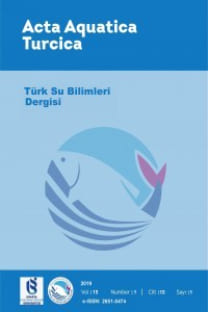Türkiye Denizleri Açık Sularının Ekim 2000'deki Fitoplankton Kompozisyonu
Fitoplankton dağılımına bağlı olarak Türkiye denizleri açık sularının verimliliğinin belirlenmesi amacıyla, Ekim 2000’de fitoplanktonun tür kompozisyonu, biyokütle ve bolluğu karşılaştırmalı olarak incelenmiştir. Karadeniz, Marmara Deniz’i, Ege Deniz’i ve Akdeniz’den yapılan 97 fitoplankton örneklemi analiz edilmiştir. Çalışmada 102 adedi tür düzeyinde olmak üzere toplam 111 takson belirlenmiştir. Ekim 2000’de tüm denizlerde 6 farklı fitoplankton grubu bulunmuştur. Bunlardan, dinoflagellatlar en yüksek tür çeşitliliği gösterirken, diyatomlar, tüm denizlerin fitoplankton biyokütlesinde en önemli role sahip olmuşlardır. Bunun dışında, en yüksek hücre bolluğuna sahip grup, Karadeniz ve Ege Denizi’nde kokkolitoforlar (başlıca Emiliania huxleyi), Marmara Denizi’nde diyatomlar ve Akdeniz’de küçük kamçılılar olmuştur. Yüzey sularında belirlenen ortalama bolluk ve biyokütle değerleri sırasıyla, Karadeniz’de 172×103 hücre l-1, 826 µg l- 1 , Marmara Denizinde 14×103 hücre l-1, 159 µg l-1, Ege Denizinde 2×103 hücre l-1, 10 µg l-1 ve Akdeniz’de 7×103 hücre l-1, 13 µg l-1 olarak bulunmuştur. Dominant türler açısından Karadeniz ile Ege Denizi arasında bir benzerlik bulunmuştur. Bir kokkolitoforid olan E. huxleyi bu iki denizde de en bol bulunan tür olmuştur. Bu tür özellikle Karadeniz’de daha bol bulunmuş ve toplam bolluğun %89’unu oluşturmuştur. Örneklemenin daha kapsamlı olmasına bağlı olarak, fitoplankton bolluğundaki dağılım, Karadeniz’de diğer denizlerden daha homojen bulunmuştur.
Anahtar Kelimeler:
Türkiye denizleri, fitoplankton, bolluk ve biyokütle
Phytoplankton Composition of Turkish Offshore Water – October 2000
In order to determination of phytoplankton characteristics of the offshore waters of Turkish seas were studied species composition, abundance and biomass of phytoplankton were comparatively investigated for October 2000. A total of 97 phytoplankton samples collected from the Black Sea, the Marmara Sea, the Aegean Sea and the Mediterranean were analysed. During the study, a total of 111 phytoplankton taxa were found and 102 of them have been identified at the species level. There were 6 different phytoplankton groups in October 2000 in all seas. From these, dinoflagellates displayed the highest species diversity. Diatoms had the highest contribution to the phytoplankton biomass of all seas. Besides, the most abundant phytoplankton groups were coccolithophores (mainly E. huxleyi) in the Black and the Aegean Seas, diatoms in the Marmara Sea and small flagellates in the Mediterranean-Levantine Basin. Average surface phytoplankton abundance and biomass values of each seas were estimated as 172×103 cells l-1, 826 µg l-1 in the Black Sea; 14×103 cells l- 1 , 159 µg l-1 in the Marmara Sea; 2×103 cells l-1, 10 µg l-1 in the Aegean Sea; and 7×103 cells l-1, 13 µg l-1 in the Mediterranean, respectively. There was a similarity in the dominant species between the Black and Aegean Seas. The coccolithophorid E. huxleyi has been dominant phytoplankton species in both seas; especially in the Black Sea, its contribution to the total abundance reaching to 89%. Based on the extensive sampling, phytoplankton seem to have a rather homogenous abundance distribution in the Black Sea compared to other seas investigated.
Keywords:
Turkish Seas, phytoplankton, abundance and biomass,
- Yayın Aralığı: Yılda 4 Sayı
- Başlangıç: 1988
- Yayıncı: Yunus Ömer BOYACI
